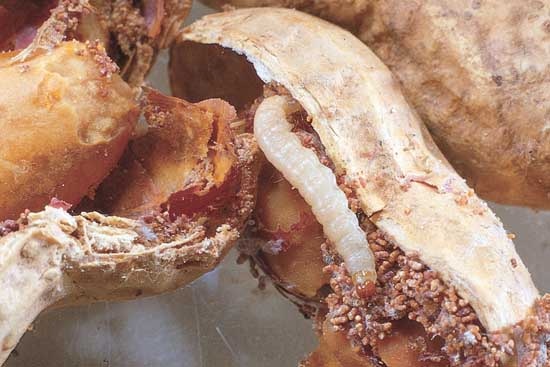pyralid moth
insect
any of a group of moths in the order Lepidoptera, most members of which have long, narrow forewings, broader hindwings, and a wingspan of 18 to 35 mm (0.75 to 1.5 inches), although a few reach to 75 mm (3 inches). Coloration is dull except for bright metallic markings. Both adults and larvae vary greatly in habitat.
 Cosmopolitan pests of stored products include the larvae of the meal moth, Indian meal moth, and Mediterranean flour moth. Meal moth (Pyralis farinalis) caterpillars are white with black heads and live in silken tubes that they spin in such grains as cereals, meal, and flour stored while damp or in damp places. The Indian meal moth (Plodia interpunctella; see photograph-->
Cosmopolitan pests of stored products include the larvae of the meal moth, Indian meal moth, and Mediterranean flour moth. Meal moth (Pyralis farinalis) caterpillars are white with black heads and live in silken tubes that they spin in such grains as cereals, meal, and flour stored while damp or in damp places. The Indian meal moth (Plodia interpunctella; see photograph--> ) originated in Europe but is now widespread throughout most of the world. The green or white larvae attack flour, grain, dried fruit, nuts, and other food products. The webs that they spin often contain their excrement and foul the infested material. The white or pink larvae of the Mediterranean flour moth (Ephestia kuehniella) are important pests of stored foods. Spinning silken tubes in which they live and feed, they attack stored grains such as wheat and maize (corn), webbing together masses of the infested grain and excrement.
) originated in Europe but is now widespread throughout most of the world. The green or white larvae attack flour, grain, dried fruit, nuts, and other food products. The webs that they spin often contain their excrement and foul the infested material. The white or pink larvae of the Mediterranean flour moth (Ephestia kuehniella) are important pests of stored foods. Spinning silken tubes in which they live and feed, they attack stored grains such as wheat and maize (corn), webbing together masses of the infested grain and excrement.Destructive borers include the European corn borer, the sugarcane borer, and the grass webworm. Adults of these species are called snout moths because their larvae are characterized by elongated snoutlike mouthparts. The larval stage of the European corn borer (Pyrausta nubilalis) is the most important insect pest of maize throughout the world. It also infests other plants, including hemp, potatoes, and gladioli. Full-grown larvae and pupating caterpillars found in the stalks of the host plant in spring emerge during the summer as yellowish-brown moths. Eggs laid on the underside of leaves hatch in about one week. The young larvae feed externally on the host plants, later boring into the stalks, leaves, stems, and ears.
White or pale yellow-brown snout moths are also known as grass, meadow, or lawn moths, depending on the habitat. They also are sometimes called close wings because the wings are held close to the body when at rest. The grass, or sod, webworm (larva of the snout moth, Crambus) usually bores into the roots, crowns, and stems of grasses, constructing silken webs around the bases and often extensively damaging crops or lawns. The sugarcane borer (Diatraea) attacks sugar, sorghums, rice, and corn. It produces up to five generations annually.
Other interesting pyralids include the wax moth (Galleria mellonella), also known as bee-moth, or honeycomb moth. The larvae usually live in beehives and feed on wax and young bees and fill the tunnels of the hive with silken threads. Bee-moth larvae are particularly destructive to old or unguarded colonies and to stored combs. Larvae of the cactus moth (Cactoblastis cactorum) destroy cactus plants by burrowing in them. The cactus moth was introduced into Australia from Argentina in 1925 as a biological control measure against the prickly pear cactus. Laetilia coccidivora is an unusual caterpillar in that it is predatory, feeding on the eggs and young of scale insects. The freshwater larvae of Acentropus occur throughout the world, feeding on water plants and either breathing through their skin and tracheal gills or obtaining oxygen from the plants.
- River Exe
- River Forest
- River Forth
- River Humber
- Rive, Richard
- Riverina
- riverine ecosystem
- River Lea
- River Liffey
- River Lune
- River Medina
- River Mersey
- River Ouse
- River Ribble
- Rivers
- Rivers, Anthony Woodville, 2nd Earl, Baron Rivers
- River Severn
- River Shannon
- Riverside
- River Slaney
- Rivers, Larry
- Riversleigh fossils
- River Spey
- Rivers, Richard Woodville, 1st Earl, Baron Rivers
- Rivers, Thomas Milton